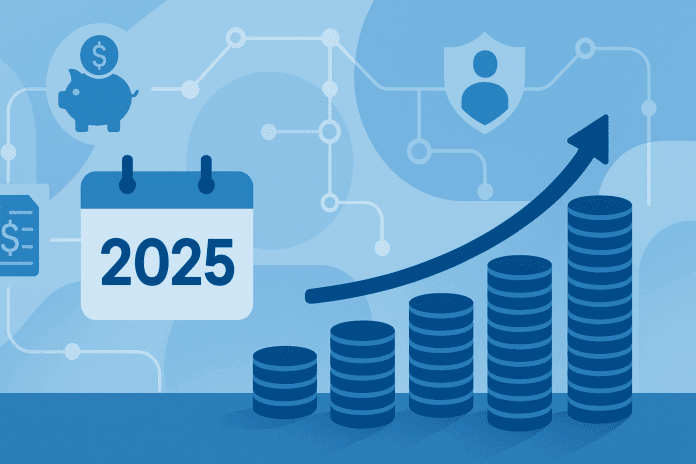The concept of the 2025 Social Security wage base is crucial for understanding how your future financial planning aligns with Social Security benefits. As we look forward to 2025, the Social Security Administration (SSA) has implemented adjustments that directly impact the earnings limit subject to Social Security taxes. This change is not only significant for those currently paying into the system but also for individuals nearing retirement who are strategizing their financial futures. In this guide, we will unravel the complexities of the 2025 Social Security wage base, explain its implications, and explore how it fits into your broader retirement planning.
You may also like: The Essential Guide to Understanding Social Security: Why Social Security Is a Good Example of Effective
What Is the Social Security Wage Base?
Before delving into the specifics of the 2025 Social Security wage base, it’s important to understand the foundation of the Social Security wage base itself. The Social Security wage base is the maximum amount of earned income that is subject to Social Security payroll tax in any given year. The wage base is adjusted annually based on national average wage trends. In practical terms, it sets the ceiling on the amount of income that can be taxed for Social Security purposes. Once your earnings surpass this threshold, you are no longer required to pay Social Security taxes on that portion of your income.
The wage base is an essential mechanism for funding Social Security benefits, as contributions are derived from both employee and employer payroll taxes. For employees, 6.2% of their income up to the wage base is allocated to Social Security, with an equal contribution from their employer. Self-employed individuals pay the full 12.4% themselves. Understanding this baseline helps clarify the impact of adjustments like those scheduled for 2025.
One of the most critical aspects of the wage base is its influence on the distribution of Social Security benefits. Because the benefits you receive are based on your average indexed monthly earnings (AIME) over your highest 35 years of earnings, contributing the maximum amount to Social Security during high-income years can substantially boost your benefit payments. This makes it essential for high-income earners to pay attention to yearly changes in the wage base, as it could mean the difference between a modest benefit and a more substantial financial cushion during retirement.

Understanding the 2025 Social Security Wage Base Increase
Each year, the Social Security Administration evaluates economic indicators to adjust the wage base. For 2025, the Social Security wage base is projected to increase, reflecting shifts in the national average wage index. This adjustment is designed to ensure that Social Security remains adequately funded while keeping pace with inflation and wage growth. Such increases mean that more of your income may be subject to Social Security taxes, which can have both short-term and long-term financial implications.
For example, if the wage base increases from its 2024 level, both employees and employers will contribute a greater amount in payroll taxes. This affects your take-home pay but also secures larger contributions towards your future Social Security benefits. For high-income earners, the increased wage base means a higher taxable income cap, which translates to more significant tax obligations but also potentially higher benefits upon retirement.
Additionally, understanding these incremental changes allows for more strategic financial planning. Workers who are nearing the maximum wage base can anticipate their tax liabilities and adjust their savings strategies accordingly. By forecasting potential changes in the wage base, individuals can better prepare for their annual tax burden and optimize their retirement savings.

How the 2025 Social Security Wage Base Impacts Retirement Planning
The rise in the 2025 Social Security wage base is more than just a tax adjustment—it has broader implications for retirement planning. Higher contributions to Social Security can enhance the benefit calculations used when determining your retirement payments. Social Security benefits are based on your 35 highest-earning years, adjusted for wage inflation. Therefore, paying more into the system during high-earning years can significantly impact the total benefits received during retirement.
Additionally, understanding the wage base adjustment allows you to anticipate your financial responsibilities and strategize accordingly. For those nearing retirement, it may influence decisions about income deferral, Roth conversions, or the timing of Social Security benefit claims. The 2025 adjustment serves as a reminder to revisit retirement plans and ensure they are aligned with current economic conditions.
Notably, the increase in the wage base also means that high earners can secure higher Social Security credits during their working years. This becomes particularly valuable if they choose to delay their Social Security claims until age 70, where maximum benefits are realized. This strategic deferral, paired with the understanding of the wage base increase, can result in a significantly larger monthly benefit during retirement.

Maximizing Your Retirement Strategy with the 2025 Social Security Wage Base
With the changes to the 2025 Social Security wage base, there are actionable steps that individuals can take to optimize their retirement planning. First, understanding your projected income in relation to the wage base helps in anticipating tax obligations. If you are a high-income earner, planning for these changes can prevent unexpected financial strain.
Moreover, strategic retirement savings vehicles such as IRAs or 401(k) plans can be adjusted to compensate for the increased wage base. By contributing the maximum allowable amounts to these tax-advantaged accounts, you can mitigate the impact of higher payroll taxes. Additionally, exploring Roth conversions during lower-income years can be a savvy way to balance taxable income and maximize Social Security benefits.
Furthermore, employing strategies like spousal benefits, survivor benefits, and understanding how income thresholds affect taxation on Social Security can make a substantial difference in net retirement income. High-income earners should also be aware of the Additional Medicare Tax, which affects those earning above specific income thresholds. Planning ahead for these potential costs will help you maintain financial stability as you transition into retirement.

Preparing for Future Adjustments Beyond 2025
The adjustment of the Social Security wage base in 2025 is part of an ongoing trend aimed at maintaining the program’s solvency. Looking ahead, it is reasonable to expect similar adjustments as average wages continue to rise. Understanding these future changes is vital for long-term retirement planning. Staying informed about annual SSA announcements and recalibrating your savings strategy can ensure you remain well-positioned for financial stability.
Furthermore, legislative changes can also impact the Social Security wage base. Policy shifts in Congress may alter the structure of Social Security taxes or adjust benefit calculations, affecting retirement strategies. Being proactive and adapting your financial plans to these changes can help secure your retirement goals despite economic fluctuations.
Anticipating these future adjustments allows individuals to make informed decisions about their Social Security strategies, including when to claim benefits and how to maximize their earnings during peak years. By staying ahead of these changes, you can enhance your financial readiness and protect your long-term retirement goals.
FAQ: Understanding the 2025 Social Security Wage Base
1. What is the purpose of the Social Security wage base?
The Social Security wage base establishes the maximum amount of income that is subject to Social Security payroll taxes each year. This limit ensures that individuals contribute proportionately based on their earnings up to a specific threshold. Income earned beyond this threshold is not subject to Social Security taxes, which means high-income earners only pay on a portion of their total earnings. The purpose of the wage base is to cap the amount of Social Security tax contributions while balancing the sustainability of benefits distributed during retirement. Adjustments to the wage base are made annually to reflect shifts in the national average wage index, keeping the system aligned with economic growth.
2. How does the 2025 Social Security wage base compare to previous years?
The 2025 Social Security wage base is projected to increase in response to rising national wage trends. Historically, the wage base sees incremental increases almost every year to account for inflation and average income growth. These adjustments ensure that the Social Security fund remains adequately supported. For instance, if the wage base in 2024 was set at $160,200, an increase for 2025 might push it to around $165,000 or more, depending on economic conditions. This upward trend reflects both the growing costs of living and the need for the Social Security Administration to maintain sufficient funding for retirees.
3. Will the 2025 Social Security wage base impact my taxes?
Yes, if your annual income exceeds the previous year’s Social Security wage base, you will be subject to higher payroll tax contributions up to the new limit. For employees, the Social Security tax rate remains at 6.2% of earnings, with employers contributing an additional 6.2%. Self-employed individuals pay the combined rate of 12.4% on earnings up to the wage base. The increase in the wage base means that a greater portion of your income could be taxed, resulting in slightly lower take-home pay but potentially higher Social Security benefits upon retirement.
4. How much does Social Security cost in relation to the wage base?
The cost of Social Security for individuals is calculated as a percentage of earnings up to the Social Security wage base. For 2025, if the wage base is set at $165,000, employees would pay 6.2% of that amount, which totals approximately $10,230. Employers match this contribution, bringing the total to $20,460 for each high-income employee. For self-employed individuals, the cost is doubled to 12.4%, resulting in about $20,460. Understanding how much Social Security costs in relation to the wage base helps individuals plan for payroll deductions and retirement benefits.
5. Why does the Social Security wage base increase each year?
The Social Security wage base increases annually to align with changes in the national average wage index. This adjustment is crucial for maintaining the solvency of the Social Security Trust Fund, which supports retirement, disability, and survivor benefits. As the cost of living and average incomes rise, the wage base must also grow to ensure the program’s financial health. These incremental increases reflect economic growth and help maintain the purchasing power of future Social Security benefits. Without these adjustments, the fund could face shortfalls as more individuals retire.
6. Can the Social Security wage base ever be lowered?
In practice, the Social Security wage base is almost always adjusted upward, not downward. This is because wage base adjustments are tied to increases in the national average wage index, which historically rises over time. However, if there were a significant economic downturn or reduction in national wage averages, it is theoretically possible for the wage base to be lowered. This has not happened in modern history, and the trend consistently points toward gradual increases to keep pace with economic growth and inflation.
7. How does the 2025 Social Security wage base affect high-income earners?
High-income earners are particularly affected by changes to the 2025 Social Security wage base because more of their income becomes subject to payroll taxes. While there is still a cap on taxable income, the gradual increases mean that a larger share of high earners’ wages is taxed each year. Although this increases their tax contributions, it also potentially boosts their Social Security benefits, as benefits are calculated based on lifetime earnings up to the wage base. Strategic planning, such as deferring income or maximizing retirement account contributions, can help mitigate the impact of these increases.
8. How is Social Security different from Medicare taxation?
Social Security and Medicare are both part of the Federal Insurance Contributions Act (FICA) but have different tax structures. Social Security taxes are limited to earnings up to the wage base, whereas Medicare taxes have no income cap. For 2025, high earners are also subject to an Additional Medicare Tax of 0.9% on wages above $200,000 for individuals or $250,000 for married couples filing jointly. Unlike Social Security contributions, Medicare taxes continue to be deducted from all wages, regardless of the total amount earned. Understanding the differences can help in planning payroll deductions and retirement strategies.
9. What happens if I earn more than the Social Security wage base?
If you earn more than the Social Security wage base, only the income up to that limit is taxed for Social Security purposes. Any additional income is not subject to the 6.2% Social Security tax, though it remains subject to Medicare tax. For high-income earners, this effectively caps the amount contributed to Social Security, although their Medicare contributions continue to rise with their income. This system is designed to balance contribution limits with the distribution of Social Security benefits during retirement.
10. Are there strategies to optimize Social Security benefits under the 2025 wage base?
Yes, there are several strategies to optimize benefits under the 2025 Social Security wage base. High-income earners can maximize contributions during peak earning years to increase their average indexed monthly earnings (AIME), which influences benefit calculations. Additionally, delaying Social Security benefits until age 70 can boost monthly payments by up to 8% per year after reaching full retirement age. Strategic use of retirement accounts, Roth conversions, and careful income management can also help maximize benefits while minimizing tax liabilities.
Conclusion: Adapting Your Financial Plan to the 2025 Social Security Wage Base
The 2025 Social Security wage base increase is more than just a numerical adjustment; it is a call to action for strategic financial planning. By understanding the implications of this change, individuals can better prepare for both short-term tax obligations and long-term retirement security. Proactive adjustments to retirement savings, income strategies, and benefit planning can help mitigate the impact of higher payroll taxes while ensuring that you maximize the benefits of your Social Security contributions. As we move towards 2025 and beyond, staying informed and adaptive is the key to safeguarding your financial future. The 2025 Social Security wage base increase is more than just a numerical adjustment; it is a call to action for strategic financial planning. By understanding the implications of this change, individuals can better prepare for both short-term tax obligations and long-term retirement security. Proactive adjustments to retirement savings, income strategies, and benefit planning can help mitigate the impact of higher payroll taxes while ensuring that you maximize the benefits of your Social Security contributions. As we move towards 2025 and beyond, staying informed and adaptive is the key to safeguarding your financial future.
To navigate these changes effectively, understanding your financial standing in relation to the Social Security wage base will allow you to make strategic decisions that protect and enhance your retirement outcomes. Planning today ensures security for tomorrow.
Further Reading:
Many Rich Americans Have Already Paid Their 2025 Social Security Taxes
How much does the US spend on Social Security? Is it sustainable?





